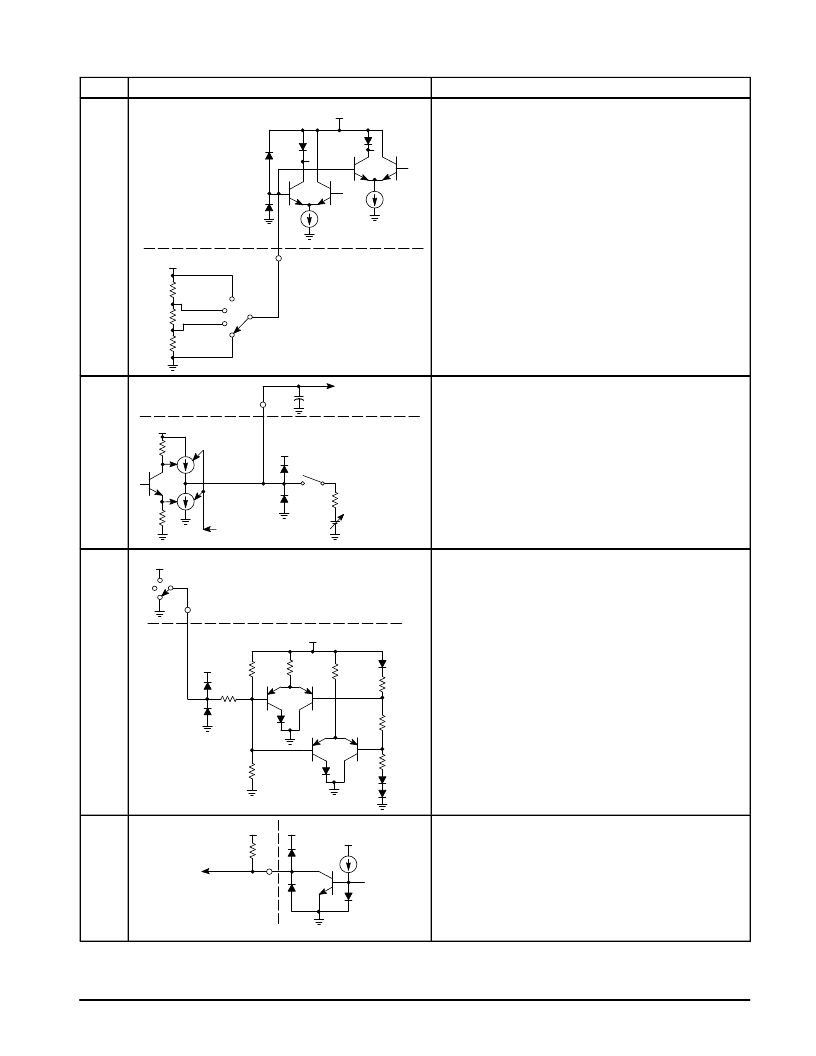- 您現(xiàn)在的位置:買賣IC網(wǎng) > PDF目錄371036 > MC44302AP (MOTOROLA INC) ADVANCED MULTI-STANDARD VIDEO/SOUND IF PDF資料下載
參數(shù)資料
| 型號(hào): | MC44302AP |
| 廠商: | MOTOROLA INC |
| 元件分類: | 消費(fèi)家電 |
| 英文描述: | ADVANCED MULTI-STANDARD VIDEO/SOUND IF |
| 中文描述: | SPECIALTY CONSUMER CIRCUIT, PDIP28 |
| 封裝: | PLASTIC, DIP-28 |
| 文件頁(yè)數(shù): | 20/28頁(yè) |
| 文件大小: | 612K |
| 代理商: | MC44302AP |
第1頁(yè)第2頁(yè)第3頁(yè)第4頁(yè)第5頁(yè)第6頁(yè)第7頁(yè)第8頁(yè)第9頁(yè)第10頁(yè)第11頁(yè)第12頁(yè)第13頁(yè)第14頁(yè)第15頁(yè)第16頁(yè)第17頁(yè)第18頁(yè)第19頁(yè)當(dāng)前第20頁(yè)第21頁(yè)第22頁(yè)第23頁(yè)第24頁(yè)第25頁(yè)第26頁(yè)第27頁(yè)第28頁(yè)

MC44302A
20
MOTOROLA ANALOG IC DEVICE DATA
PIN FUNCTION DESCRIPTION (continued)
Pin No.
Description
Equivalent Internal Circuit
10
Video Mode Switch
3.0 k
VCC
V1
V2
VCC
2.4 k
5.1 k
PAL 1
PAL 2
SECAM
NTSC
10
Video Mode Switch
A dc voltage at this input selects the proper video AGC and sound
demodulation technique for PAL, SECAM, and NTSC. With PAL
1 selected, AGC is keyed on the sync pulse by the horizontal PLL
which is locked to the flyback or video sync pulse present at Pin 17.
The FM sound IF and detector is active. The PAL 2 selection is
identical to PAL 1 with the addition of sound muting when the
acquisition circuit is unlocked or vertical sync is absent. With
SECAM selected, the video level is established by both, a long
time constant peak white detector, and a back porch keyed AGC
that corrects for transmitted black level errors while maintaining
fast AGC response. The AM sound detector is active. With NTSC
selected, AGC and sound muting is the same as in PAL 1 mode.
The FM and AM detectors are both active with the FM output at
Pin 27 and the AM output at Pin 24. Refer to Table 2.
11
11
AFT Ouput
VCC
3.3
VCC
Digital Slew
Rate Control
To Tuner AFT Input.
IO must be externally
limited < 4.0 mA.
0 to
±
500
μ
A
or
±
2.0 mA
Variable
Reference
Clamp Voltage
20
AFT Output
With detent type tuners, the automatic fine tuning output can be
used to directly control the tuner local oscillator varactor. The
varactor control input must be high impedance in order to maintain
high AFT loop gain with acceptable dynamic response. This
output has a linear sink and source current range of 0 to 500
μ
A,
and is digitally switched to
±
2.0 mA for large frequency errors. The
capacitor from Pin 11 to ground limits the bandwidth of the tuner
local oscillator loop. Digital phase–locked loop tuning systems
can also be controlled with the addition of a varactor diode used
to shift the PLL reference oscillator. Refer to Figures 6, 24, and 25.
12
AFT Mode Switch
VCC
VCC
VCC
12
24 k
24 k
5.1 k
AFT Mode Switch
This input is used to activate the output of the AFT control amplifier
that appears at Pin 11, and to select the control voltage polarity
versus IF frequency. This feature allows the AFT output to work
with all types of varactor tuned local oscillators. With the AFT
Mode Switch input connected to VCC, Pin 11 is placed in a
sourcing mode when the IF carrier frequency is below nominal.
With the AFT Mode Switch input grounded, Pin 11 is placed in a
sinking mode when the IF carrier frequency is below nominal. With
the AFT Mode Switch input disconnected, Pin 11 is internally
clamped to one half of VCC, refer to Figures 6 and 25.
13
VCC
VCC
VCC
RF AGC
Output
10 k
To Tuner
AGC Input
13
RF AGC Output
This output is designed to control a reverse AGC tuner. As the
antenna signal level increases, the voltage at Pin 13 decreases,
causing a gain reduction in the tuner RF stage. An external pull–up
resistor must be added if one is not provided in the tuner. Pin 13
is guaranteed to sink a minimum of 1.0 mA. Note that when
operating with a tuner that requires in excess of 5.6 V, current will
flow into Pin 13 due to conduction of the upper internal clamp
diode.
相關(guān)PDF資料 |
PDF描述 |
|---|---|
| MC44353DTB | MULTI.STANDARD AND PAL/NTSC MODULATOR ICs |
| MC44353 | MULTI.STANDARD AND PAL/NTSC MODULATOR ICs |
| MC44355DTB | MULTI.STANDARD AND PAL/NTSC MODULATOR ICs |
| MC44354DTB | MULTI.STANDARD AND PAL/NTSC MODULATOR ICs |
| MC44354DW | MULTI.STANDARD AND PAL/NTSC MODULATOR ICs |
相關(guān)代理商/技術(shù)參數(shù) |
參數(shù)描述 |
|---|---|
| MC4433 | 制造商:SHENZHENFREESCALE 制造商全稱:ShenZhen FreesCale Electronics. Co., Ltd 功能描述:P-Channel 30-V (D-S) MOSFET Fast switching speed |
| MC4435 | 制造商:SHENZHENFREESCALE 制造商全稱:ShenZhen FreesCale Electronics. Co., Ltd 功能描述:P-Channel 30-V (D-S) MOSFET Fast switching speed |
| MC44353 | 制造商:MOTOROLA 制造商全稱:Motorola, Inc 功能描述:MULTI.STANDARD AND PAL/NTSC MODULATOR ICs |
| MC44353DTB | 制造商:MOTOROLA 制造商全稱:Motorola, Inc 功能描述:MULTI.STANDARD AND PAL/NTSC MODULATOR ICs |
| MC44353DW | 制造商:MOTOROLA 制造商全稱:Motorola, Inc 功能描述:MULTI.STANDARD AND PAL/NTSC MODULATOR ICs |
發(fā)布緊急采購(gòu),3分鐘左右您將得到回復(fù)。